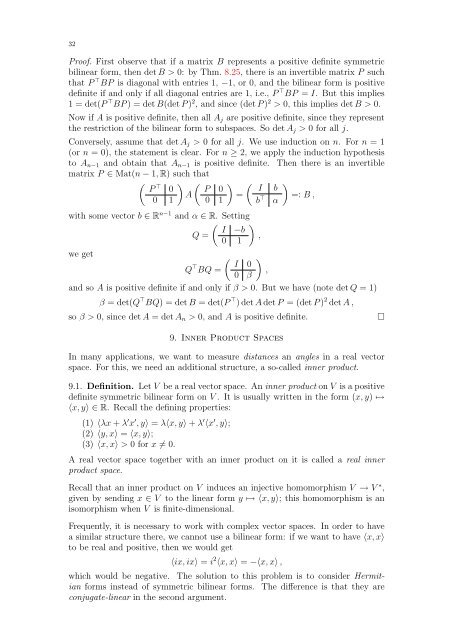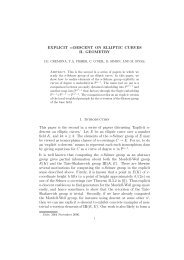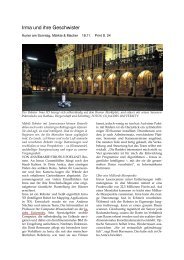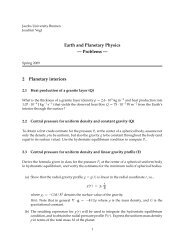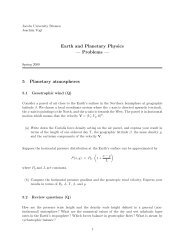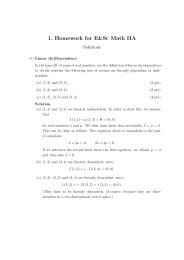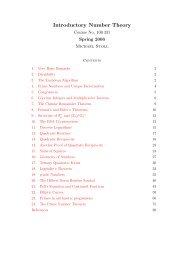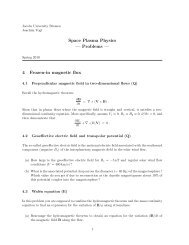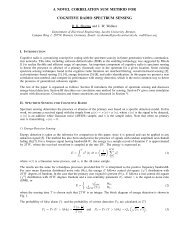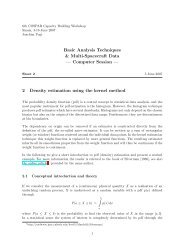Linear Algebra II (pdf, 500 kB)
Linear Algebra II (pdf, 500 kB)
Linear Algebra II (pdf, 500 kB)
You also want an ePaper? Increase the reach of your titles
YUMPU automatically turns print PDFs into web optimized ePapers that Google loves.
32<br />
Proof. First observe that if a matrix B represents a positive definite symmetric<br />
bilinear form, then det B > 0: by Thm. 8.25, there is an invertible matrix P such<br />
that P ⊤ BP is diagonal with entries 1, −1, or 0, and the bilinear form is positive<br />
definite if and only if all diagonal entries are 1, i.e., P ⊤ BP = I. But this implies<br />
1 = det(P ⊤ BP ) = det B(det P ) 2 , and since (det P ) 2 > 0, this implies det B > 0.<br />
Now if A is positive definite, then all Aj are positive definite, since they represent<br />
the restriction of the bilinear form to subspaces. So det Aj > 0 for all j.<br />
Conversely, assume that det Aj > 0 for all j. We use induction on n. For n = 1<br />
(or n = 0), the statement is clear. For n ≥ 2, we apply the induction hypothesis<br />
to An−1 and obtain that An−1 is positive definite. Then there is an invertible<br />
matrix P ∈ Mat(n − 1, R) such that<br />
P ⊤ 0<br />
0 1<br />
<br />
P 0<br />
A<br />
0 1<br />
<br />
=<br />
with some vector b ∈ Rn−1 and α ∈ R. Setting<br />
<br />
I −b<br />
Q =<br />
,<br />
0 1<br />
I b<br />
b ⊤ α<br />
<br />
=: B ,<br />
we get<br />
Q ⊤ <br />
I<br />
BQ =<br />
0<br />
<br />
0<br />
,<br />
β<br />
and so A is positive definite if and only if β > 0. But we have (note det Q = 1)<br />
β = det(Q ⊤ BQ) = det B = det(P ⊤ ) det A det P = (det P ) 2 det A ,<br />
so β > 0, since det A = det An > 0, and A is positive definite. <br />
9. Inner Product Spaces<br />
In many applications, we want to measure distances an angles in a real vector<br />
space. For this, we need an additional structure, a so-called inner product.<br />
9.1. Definition. Let V be a real vector space. An inner product on V is a positive<br />
definite symmetric bilinear form on V . It is usually written in the form (x, y) ↦→<br />
〈x, y〉 ∈ R. Recall the defining properties:<br />
(1) 〈λx + λ ′ x ′ , y〉 = λ〈x, y〉 + λ ′ 〈x ′ , y〉;<br />
(2) 〈y, x〉 = 〈x, y〉;<br />
(3) 〈x, x〉 > 0 for x = 0.<br />
A real vector space together with an inner product on it is called a real inner<br />
product space.<br />
Recall that an inner product on V induces an injective homomorphism V → V ∗ ,<br />
given by sending x ∈ V to the linear form y ↦→ 〈x, y〉; this homomorphism is an<br />
isomorphism when V is finite-dimensional.<br />
Frequently, it is necessary to work with complex vector spaces. In order to have<br />
a similar structure there, we cannot use a bilinear form: if we want to have 〈x, x〉<br />
to be real and positive, then we would get<br />
〈ix, ix〉 = i 2 〈x, x〉 = −〈x, x〉 ,<br />
which would be negative. The solution to this problem is to consider Hermitian<br />
forms instead of symmetric bilinear forms. The difference is that they are<br />
conjugate-linear in the second argument.


